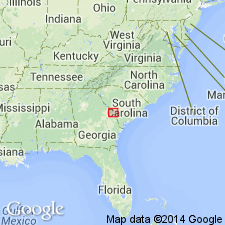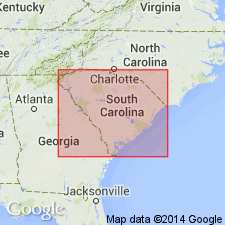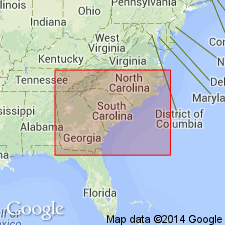
- Usage in publication:
-
- Steel Creek Formation
- Modifications:
-
- Named
- Dominant lithology:
-
- Sand
- Clay
- AAPG geologic province:
-
- Atlantic Coast basin
Summary:
Steel Creek Formation, a new unit at the Savannah River site, is composed of quartz sand and interbedded kaolinite clay. Sediments in the lower part of the formation consist of tan, light to dark gray, orange, and yellow poorly to well-sorted, fine to coarse quartz sand and silty sand, very micaceous in places. Pebbly zones and layers of clay clasts are common. Upper part in most places is oxidized, kaolinitic clay, with orange, red, gray, purple, and yellow coloring, interbedded with sands in places. Clay is up to 60 ft thick, but absent in some cores. Thickness ranges from 60 ft at the northwestern boundary of the study area to 140 ft at the southeastern boundary. These sediments have been assigned to the Middendorf, Black Creek, and Peedee by previous workers. Probably deposited in delta plain environment. Overlies Black Creek Formation and underlies Sawdust Landing Formation. Correlates with middle and upper Ripley and Providence formations of GA and AL. Maastrichtian age suggested by pollen and dinoflagellates.
Source: GNU records (USGS DDS-6; Reston GNULEX).

- Usage in publication:
-
- "Steel Creek beds"
- Modifications:
-
- First used
- Dominant lithology:
-
- Sand
- Clay
- AAPG geologic province:
-
- Atlantic Coast basin
Summary:
Unconformably(?) overlying the Black Creek Formation is a section of yellow, tan, and gray, moderately sorted sand and interbedded sand and variegated clay, about 70 ft thick which is here informally referred to as the "Steel Creek beds." The beds may be time equivalent to the Peedee Formation. The sediments are more similar, however, to those in the upper part of the Black Creek at its type area and both are Maastrichtian. The Steel Creek beds may be later assigned to the Black Creek.
Source: GNU records (USGS DDS-6; Reston GNULEX).

- Usage in publication:
-
- Steel Creek Formation
- Modifications:
-
- Named
- AAPG geologic province:
-
- Atlantic Coast basin
Summary:
Steel Creek Formation is formally proposed in this report. Its definition is identical to that published by Fallaw and Price (1992) and summarized above. Unit grades into calcareous siliciclastics of the Peedee Formation of northeastern and southeastern SC. To the southwest, it grades into the calcareous sands of the Ripley and Providence Formations of western GA. The lateral limits of the Steel Creek are arbitrarily placed where the calcium carbonate content of the sediments is 5 percent. Upper and lower contacts are unconformable.
Source: GNU records (USGS DDS-6; Reston GNULEX).
For more information, please contact Nancy Stamm, Geologic Names Committee Secretary.
Asterisk (*) indicates published by U.S. Geological Survey authors.
"No current usage" (†) implies that a name has been abandoned or has fallen into disuse. Former usage and, if known, replacement name given in parentheses ( ).
Slash (/) indicates name conflicts with nomenclatural guidelines (CSN, 1933; ACSN, 1961, 1970; NACSN, 1983, 2005, 2021). May be explained within brackets ([ ]).

